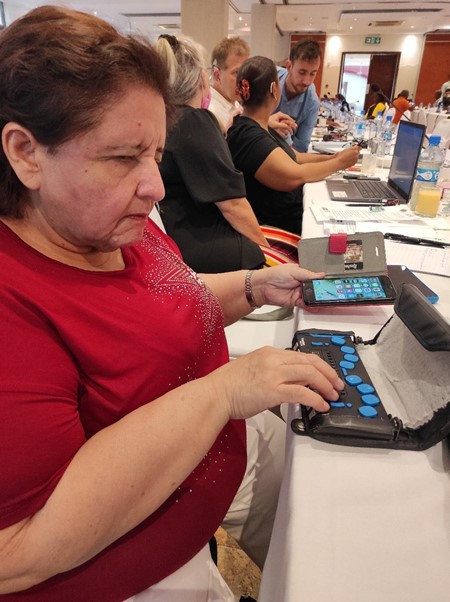
Sonnia Margarita, an older woman with deafblindness, is using a braille line to navigate through her mobile device to access and test different applications (Apps) produced by the SHAPES project in her mobile device.
Picture taken by WFDB in Nairobi, Kenya.
The Smart and Healthy Ageing through People Engaging in Supportive Systems, or SHAPES project, is a four-year project (2019-2023) that intends to build, pilot, and deploy a large-scale, standardised open platform for the European Union (EU), integrating a broad range of technological, organisational, clinical, educational, and societal solutions for long-term, health, and active ageing. More specifically, this project looks at technology in the home and in local communities to reduce health and social care costs, hospitalisations, and institutional care of older persons.
WFDB is one of 36 consortium partners, composed of researchers, technology companies, and civil and public organisations aimed at helping older persons, across 14 EU countries and engaging with over 2,000 older persons, caregivers, and service providers. The main objective is to improve the long-term sustainability of health and social care systems in Europe and improve the independence and autonomy of older persons.
This project focuses on two main outputs:
Persons with deafblindness have been involved in activities to collect data, such as interviews, focus groups, and workshops, on the following areas to inform digital solutions:
A number of measures were adopted to ensure the inclusion of persons with deafblindness in the project. WFDB advocated for a budget line for interpreter-guides/Deafblind interpreters for meetings and travel to ensure that the participation of persons with deafblindness was meaningful and equal to project participants without deafblindness. Persons with deafblindness worked with interpreter-guides/Deafblind interpreters to participate in the data collection activities, and some of these activities worked with smaller cohorts to adapt to the communication requirements of the group. For example, focus groups usually involved 2-3 participants with deafblindness, and workshops comprised of 7-10 participants with deafblindness.
Many of the project events were integrated so that WFDB could connect with other project partners and to raise the profile of persons with deafblindness among mainstream partners. For example, at one of the online meetings, a person with deafblindness presented on a panel while another person with deafblindness moderated the panel. WFDB also provided guidance and technical support across the project on how to make information accessible (e.g., through accessible formats) and ensured use of CRPD-compliant language. For instance, WFDB provided advice on a promotional video to improve the colour contrast and add subtitles.
WFDB hired a project coordinator without deafblindness for this fast-paced, complex project, but this coordinator filtered all decisions through WFDB’s president and regional representatives to maintain ownership by persons with deafblindness. For example, WFDB’s senior leadership selected the participants for the data collection activities to ensure diversity of communication methods among cohorts. Having a project coordinator helped to ensure activities were implemented in a timely manner, but persons with deafblindness drove the project and project-related decisions.
The good practices for including persons with deafblindness in mainstream projects learned from SHAPES include:
The SHAPES project has provided a platform for persons with deafblindness to come together on health and technology issues, resulting in a positive exchange with mainstream organisations, new connections and partnerships with mainstream organisations, and peer-to-peer learning between persons with deafblindness. WFDB plans to consolidate learning from the SHAPES project and produce a final report highlighting learning on project participation of persons with deafblindness as well as insights on health and technology for older persons with deafblindness.